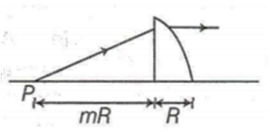 Multiple Choice Questions
Multiple Choice QuestionsA light movs from denser to rarer medium, which of the following is correct?
Energy increases
Frequency increases
Phase changes by 90°
Velocity increases
For a given lens, the magnification was found to be
twice as large as when the object was 0.15 m
distant from it as when the distance was 0.2 m. The
focal length of the lens is
1.5 m
0.20 m
0.10 m
0.05 m
The two lenses of an achromatic doublet should have
equal powers
equal dispersive powers
equal ratio of their power and dispersive power
sum of the product of their powers and dispersive power equal to zero
D.
sum of the product of their powers and dispersive power equal to zero
The two lenses of an achromatic doublet should have, sum of the product of their powers and dispersive power equal to zero.
A luminous object is placed at a distance of 30 cm from the convex lens of focal length 20 cm. On the other side of the lens, at what distance from the lens a convex mirror of radius of curvature 10 cm be placed in order to have an upright image of the object coincident with it
30 cm
60 cm
50 cm
12 cm
A point source of light is placed 4 m below the surface of water of refractive index 5/3. The minimum diameter of a disc which should be placed over the source on the surface of water to cut-off all light coming out of water is
6 m
3 m
4 m
2 m
To get three images of a single object, we should have two plane mirrors at an angle of
60o
90o
120o
30o
A vessel of depth t is half filled with a liquid having refractive index n1 and the other half is filled with water of having refractive index n2. The apparent depth of the vessel as viewed from top is
A fish rising vertically to the surface of water in a lake uniformly at the rate of 2 m/s observes a kingfisher diving vertically towards the water at a rate of 10 m/s. If refractive index of water n = what will be the actual velocity of the kingfisher
10 m/s
8 m/s
6 m/s
9 m/s
A square wire of side 2.0 cm is placed 20 cm in front of a concave mirror of focal length 10 cm with its centre on the axis of the mirror and its plane normal to the axis. The area enclosed by the image of wire is
7.5 cm2
6 cm2
2 cm2
4 cm2
A quarter cylinder of radius R and refractive index 1.5 is placed on a table. A point object P is kept at a distance ofmR from it as shown in figure. For what value of m for which a ray from P will emerge parallel to the table?

